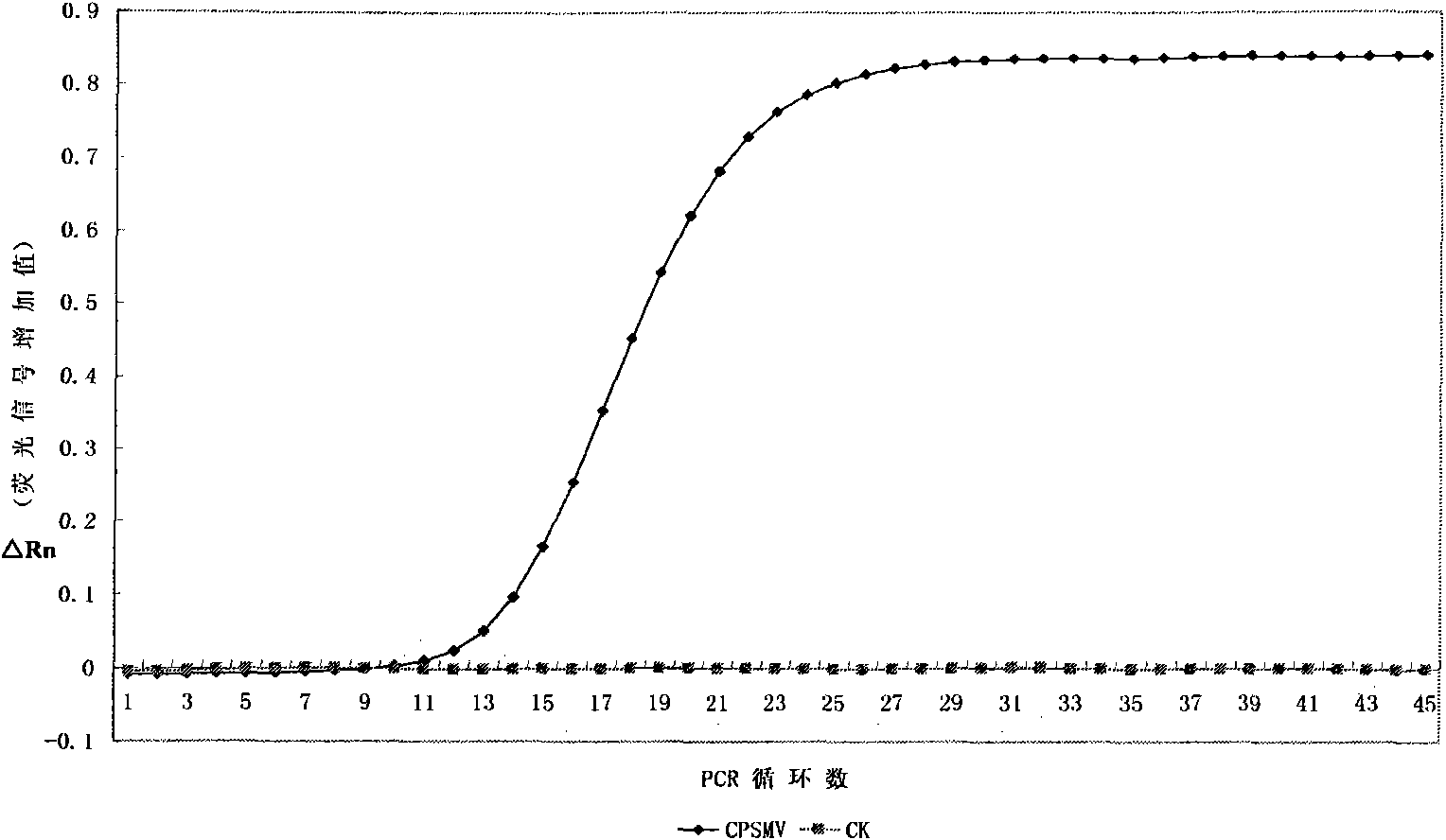Molecule detection method for cowpea severe mosaic virus
A molecular detection and leaf virus technology, applied in the biological field, can solve the problems of insufficient speed, sensitivity, and accuracy, and achieve high sensitivity, good specificity, and good repeatability
- Summary
- Abstract
- Description
- Claims
- Application Information
AI Technical Summary
Problems solved by technology
Method used
Image
Examples
Embodiment 1
[0018] Embodiment 1 utilizes the inventive method to detect cowpea heavy mosaic virus
[0019] The specific detection method is as follows:
[0020] 1. Preparation of sample virus crude extract
[0021] 1.1 Selection and sowing of infected CPSMV seeds: according to the symptoms and characteristics of cowpea infection after the virus, select seeds with small grains and flattened grains, and wash three times with sterile water after surface disinfection with 3% (m / v) sodium hypochlorite for 10 min. , sow the seeds in sterilized soil, and the pots and utensils used are all sterilized.
[0022] 1.2 Selection of infected plants and preparation of virus crude extracts: after the emergence of cowpea seedlings and the flattening of the first pair of true leaves, prepare a sample from a single plant showing suspicious symptoms; for asymptomatic plants, take 1 leaf per plant, A sample was prepared from the leaves of each plant. Each sample contains 0.1 g of fresh leaf tissue, to whic...
Embodiment 2
[0054] Embodiment 2 utilizes the inventive method to detect the specificity of cowpea heavy mosaic virus
[0055] 1. Viral RNA extraction for specificity verification
[0056] Select cowpea mosaic virus (CPMV) and bean pod mottle virus (BPMV) of the same genus as cowpea heavy mosaic virus (comovirus genus Comovirus), another nematode-borne polyhedron virus of the same family (comoviridae) Genus (Nepovirus) Tobacco Ringspot Virus (TRSV), and Black-eyed Cowpea Mosaic Virus (BlCMV), another important seed-transmitted virus on cowpea, Potatovirus Y, were used for RT-Real time PCR of Cowpea Heavy Mosaic Virus (CPSMV) Verification of specificity. The above-mentioned tested viruses were all from the American Type Culture Collection (ATCC). The negative control was the leaves of healthy cowpea.
[0057] Add 1 mL of sample extraction buffer to the leaves (0.1 g) of plants infected with each virus and grind, centrifuge for 10 min at a centrifugal force of 10,000 g, and the supernatan...
Embodiment 3
[0081] Embodiment 3 utilizes the inventive method to detect the sensitivity of cowpea heavy mosaic virus IC-RT-Real time PCR
[0082] 1. Preparation of Cowpea Heavy Mosaic Virus Sample Crude Extract
[0083] Weigh 100mg of cowpea heavy mosaic virus diseased leaf tissue, add 1mL of sample extraction buffer to grind, centrifuge at 10000g for 10min, the supernatant is the virus crude extract, and the concentration of the supernatant is 100mg / mL virus crude extract. Then use the sample extraction buffer to dilute step by step with a 10-fold gradient to a crude virus extract with a concentration of 10 mg / mL, 1 mg / mL, 100 μg / mL, 10 μg / mL, 10 ng / mL, and 1 ng / mL.
[0084] 2. Preparation of Immunocapture PCR Tubes
[0085] Take the CPSMV coating antibody, dilute it to the working concentration with coating buffer, pipette 25 μL into the PCR tube, and place it at room temperature for 4 hours or incubate overnight in a refrigerator at 4°C. Wash 3 times with washing buffer (PBST), add 2...
PUM
 Login to View More
Login to View More Abstract
Description
Claims
Application Information
 Login to View More
Login to View More - R&D
- Intellectual Property
- Life Sciences
- Materials
- Tech Scout
- Unparalleled Data Quality
- Higher Quality Content
- 60% Fewer Hallucinations
Browse by: Latest US Patents, China's latest patents, Technical Efficacy Thesaurus, Application Domain, Technology Topic, Popular Technical Reports.
© 2025 PatSnap. All rights reserved.Legal|Privacy policy|Modern Slavery Act Transparency Statement|Sitemap|About US| Contact US: help@patsnap.com


